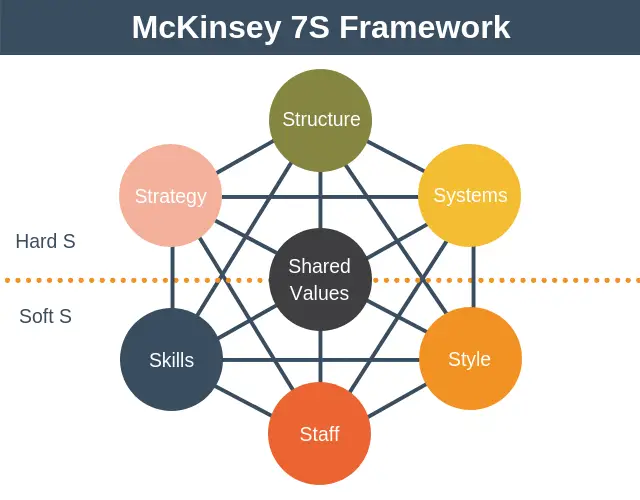McKinsey 7S Framework
The McKinsey 7S Framework is a strategic planning tool used to evaluate the way an organization is set
up by focusing on seven areas within it. The tool that focuses on an organization’s internal components
to include strategy, systems, structure, shared values, style, staff, and skills. The framework
is used to identify how well the area executes actions that align with business objectives.
The development of this framework was a collaborative effort, beginning as early as the late 1970s and early 1980s by McKinsey & Company’s consultants, Tom Peters, and Robert Waterman. Though the
framework has been used in various business settings, making it a worthwhile option to explore with
little limitations regardless of the size of a business or the industry, it seems that medium to large sized businesses has experienced the most success with this framework.
The seven parts of the framework are made of up “hard” and “soft” Ss. The hard Ss are considered to
be strategy, systems, and structure. The soft Ss are skills, staff, shared values, and style. An organization’s shared values are the core of the framework, tying both hard and soft Ss together to
emphasize the important connections. To better understand the focus of each S, refer to the descriptions below.
- Strategy: Strategy entails having a sound plan that is easy to understand and comprehend, has
longevity, and supports the organization’s desired accomplishments. An organization’s strategy
choice should align well with the organization’s goal statements. - Systems: Systems are the processes an organization implements to conduct daily or common business practices.
- Structure: Structure involves the way in an organization is organized and how roles are assigned to manage the organization’s functions. This area of the framework is considered the easiest within the for making changes.
- Skills: Skills are what employees must be capable of doing to perform. This is closely related to
the needed competency for job roles within the organization. - Staff: The staff is a specific resource relating to the organization’s employee or workforce and
the related job roles necessary for the organization to function. - Shared Values: The core of the framework is shared values. These are the set standards that help to ensure business practices align with goals the organization has expressed and intends to accomplish.
- Style: Style is the manner the company manages various business areas, job roles, and other
resources. It determines the way these sectors communicate or work together.
The McKinsey 7S Framework can be used to help an organization in identifying what’s not working well
or accurately, verify and effective management design, determine needed changes, and act as a
guideline for selecting the most appropriate solutions for resolving any discovered discrepancies.

References:
Pressler, E. J. (2014). Logging in to Learning Analytics. Current Issues in Emerging eLearning 1(1),
6.
Addagada, T. (2012). Do We Need a Mature GAP Analysis? Retrieved on April 2, 2019 from
http://www.batimes.com/articles/do-we-need-a-mature-gap-analysis.html
